The Goal
With our guitar products, the goal is to study the relationships between the parts and then make things that solve real world problems for guitar players.
Products Catalog
Bill Edwards Locking Nut
"I wish this came standard on all locking nuts. Such a time saver."
Marc Tozzo via the Internet
"Congratulations for your idea and for making this locking nut so efficient! It is a great example of smart engineering. I wouldn't choose anything else. When things tend to be perfect, you need very few words to describe them! All locking nuts on the planet should be like this one! I often use the guitar synth, and it requires the strings to stay in perfect tune - zero tolerance. The Bill Edwards Finger-Tite does the job perfectly!"
Christian Bonciu Romania
"Also, just wanted to say that these will be my 2nd, 3rd, and 4th Bill Edwards lock nuts that I’ve purchased from you and I really like their looks and functionality. Happy to pay for quality pieces. Thank you!"
Calen Harvey Chico CA
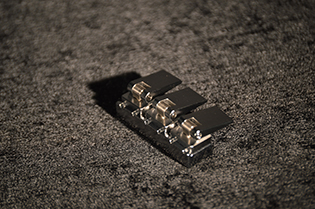
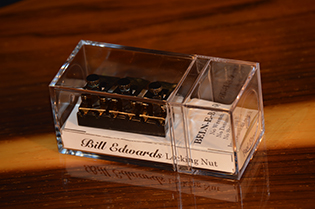
Behind Nut String Lock
"Hey there Bill. I just wanted to say that, having worked with your behind the string nut lock for weeks now, your invention is the best thing ever. I love having instant access to my regular tuners. The internal adjusters are no big deal at all to set, and I love the clean and cool look of it. Most importantly, it just works, exactly as you detail in your description and the minimalistic design just feels like you're working with an inspired work of engineering. I'm impressed. Thanks so much for making your inventions available to us regular jackasses. It's amazing how much it enhances the enjoyment of using a trem (in my case, a Kahler stud mount) when access to your regular tuners is a breeze. In contrast to the ubiquitous locking nuts of which we're all aware, there is no longer another impediment between the trem-abusive guitarist and tuning stability. All the Best."
Djerek Kayzakian-Rowe Denver CO
Floyd Nut Conversion Kit
"This thing works great!!! You should make a fortune on this. Best thing to happen to a FR since it was invented!! I’ll be ordering 2 or 3 more and showing this to my friends on the Dan Reed Network tour! Thank you so much!!!"
Brion James Limhamn Sweden
"You have no idea how awesome this is... Well.. Of course you do! You invented it! I'm amazed. It works really really well and makes my crazy tuning needs (switching from drop C to G) easy to deal with. SO GOOD, IT MUST BE WITCHCRAFT! This is really cool though. I can show up with 1 or 2 guitars instead of 4 or 5. Usually, my Floyd's would stay home... And my non-Floyd's go out of tune a lot because they don't lock. Now, I don't have to worry about it."
Christian Noir Clearwater FL
Shipping Info
Orders are shipped via USPS Priority Air or Priority Air International.
Orders are shipped by weight in the following increments:
.01 lbs. - 2 lbs. United States: $10.00; Canada: $31.00; All Other Countries: $42.00
2.01 lbs. - 4 lbs. United States: $17.00; Canada: $57.00; All Other Countries: $88.00
Over 4 lbs. Please contact us.
IMPORTANT NOTE: On the PayPal payment page, the "Destination Country" field is located ABOVE the field where you
enter your name and is actually a scrolling field which defaults to the United States. If you are shipping to a different
country you must manually scroll this field to the destination country. Otherwise delays may be incurred.Note: To arrange shipping via UPS, Fedex, DHL or other carriers, please contact us
directly via email, text or phone.FAQs
To explain this sufficiently and hopefully in an interesting way, first I’d like to go back to the beginning, in the 1980s when I owned a guitar store that did a lot of repairs, building and customization. The Floyd Rose double-locking tremolo actually stayed in tune by eliminating the string slippage and friction at the nodes (ie., the bridge saddles and nut slots.) (Nothing else works sufficiently: locking tuners, roller bearings, greased nut slots etc., will produce or allow slippage and friction that results in detuning. This simple fact, however, doesn't stop people from making and selling all kinds of this crap.) Unfortunately, as many of my store customers found out at the most inopportune times, the hex cap screws and allen wrenches used in the Rose to lock the strings at the nut also twisted the string pairs (between the lock blocks and the baseplate) out of tune - and not in a predictable or precise way. While neither Floyd Rose nor Helmut Schaller, the manufacturer, could solve this problem, they came up with a simple workaround: the fine tuners from early violin technology (later adopted by Gibson for a stop tailpiece and yes, manufactured by Schaller) would be adapted to fit to the Rose bridge. For Kramer and Rose, this was a solution they felt was sufficient (in spite of the fact the bass “E” fine tuner screw was in the way of your picking hand). At the very same time however, I had been working on a locking solution that simply did not require an external tool. After a couple of years and several false starts, a cam and lever shape was produced that had sufficient mechanical advantage to do the job of retaining the string pairs against their full force up to pitch. (!) We had ground down our Lock Blocks to the optimal height for a given string gauge to achieve the correct positioning or “timing” of the Cam Lever and the combination was just as strong or stronger than the Rose/Kramer/Schaller/locking nut. Interestingly, the action of locking the strings did not affect the strings and therefore did not detune the strings - even when unlocking. This was an significant and unexpected benefit. I had contacted several potential (usually skeptical) licensees to measure interest and line up production and distribution (including Kahler, DiMarzio and Hoshino/Ibanez, to name a few) and we agreed to meet at the next trade show and they could see it in action for themselves and dispel their doubts. At the NAMM show in Anaheim, Floyd Rose approached me and said he’d tried and failed to make a design like mine. Interestingly and disturbingly, he also started to show me ways to “improve” my design - none of which would have worked and we ended up in an argument less than five minutes after we’d met. (At the time it seemed like he had simultaneously forgotten that he’d been unable to solve the problem himself and was unable to appreciate how much time and effort it took me to find a workable solution.) Anyway, he asked to show my design to the Kramer people (mainly Dennis Berardi, Kramer president) and they expressed a serious interest in it. I felt that joining them would insulate me from a possible “lawsuit of attrition” from Rose and the association with Van Halen and Kramer would insure universal adoption and create a new and better standard for locking nuts. At the time, the Kramer electric was the best selling guitar in the world due in a large part to the Van Halen endorsement and the Rose tremolo. I joined Kramer via an license (said to be identical to Floyd Rose’s but with suspicious whitespace gaps) and at the very next show six months later, they took enough orders to make me an overnight millionaire. Production, however was stalled. There were none to sell. While I’d given Kramer an exclusive license for my invention, Kramer had given Schaller the job of making the parts. Schaller had survived WWII (yes, an ex-Nazi) and eventually managed to put together a factory that made parts inexpensively for American guitar manufacturers, namely Gibson and Fender among others. The strength of the dollar against the German mark seemed to be a significant part of that equation at the time. Like most people, I became familiar with the Schaller name via his tuning machines, which were among the first to feature sealed, permanently lubricated worm/gear mechanisms. It was considered a quality product. I found out later that Schaller, however, was still stuck in a post-WWII manufacturing mentality in the 1980s. His factory model was based on rooms of dozens of low-paid German women working at tables pulling levers on mechanisms designed to assemble various parts into completed assemblies. My invention was made possible by CNC (computer numerical control) accuracy and tolerances of .001” or greater. Bluntly put: his manufactured prototypes did not work worth a shit. Not only that, he was an “arrogant sumbitch” as my grandad would say. Rather than making what was actually on my precisely-drawn print, he attempted to redesign my carefully researched Cam Lever profile to fit his own half-assed idea of how it should work. Who does that remind you of? Correct. Floyd once told me that he and Helmut “don’t get along very well.” Not only was Schaller unable to hit the center of the cam correctly, he made parts that would simply break when you exerted the force necessary to clamp! My frustration was mounting. To make matters worse, I’d been relegated by Schaller to dealing with his son, Rene, who I considered to be nothing more than a dilettante. Rene had recently come back to work for his father because he’d gone bankrupt trying to run a casino - as he told it. He claimed to be an “engineer” but when I asked for his schooling credentials he allowed as how he wasn't “that kind of engineer.” Like Floyd had done a year or two earlier, I was sent to Germany to find out what the problem was at the Schaller factory and get the parts made to fill the tens of thousands of orders that Kramer had amassed. The problem was obvious: they did not have the technology sufficient to build the part correctly. My prototypes had been made with CNC accuracy, but Schaller was still stuck in 1940s. During this delay I started to ask some pointed questions about how they were going to meet their obligations to Kramer and some revealing explanations for the delays were being offered. They had been approached by Fender to produce a similar product for their guitars and had been spending time reverse-engineering my invention for Fender instead of making parts for Kramer! I couldn’t believe it. This was a kind of betrayal and corruption that I’d never experienced before. I later found out the Helmut had (barely concealed) contempt for Kramer, Berardi and Rose. He considered them “upstarts” and favored his older clients like Gibson and Fender. To my horror, I suddenly realized that I was at the center of an international corporate espionage in the guitar industry. While all this was going on, Kahler, whom I’d never even gotten a chance to talk to at NAMM, decided to do what Fender was doing: reverse engineer my invention and make copies of my work. I found out that Yamaha had also filed a patent in Japan less than a month after the NAMM show for what seemed to be (from the drawings) an identical copy of my invention. I later found out later Hoshino/Ibanez also made a copy. The list of copycats got very long very fast. I’ll admit that I’d underestimated the potential impact of my invention on the guitar industry. One thing the copies had in common is they had fatal flaws. They all rushed to market to claim a share of what they were sure would be a big winner. They all failed to take into account the subtleties that made my design work. I was told by Berardi at some point that the public would not accept my design as is, where the user had to grind down the Lock Blocks to the correct size for their strings. For me, this was a five minute procedure and easily done. Not a big deal. You’d only need to do this again if you changed the string gauges and I’d allowed for a lot of material on the Blocks for this very reason. We’re talking a few thousandths of an inch and a couple of minutes time with a grinder or some sandpaper. Schaller was taking directions from Berardi on this and I was stuck in a contract that had not paid me a nickel. At one point Schaller (I’m not kidding…) suggested we attach a flat spring to the bottom of the Baseplate! Yeah… you’re an engineer. So in desperation I came up with an intermediary device that allowed the Cam-Screw Assembly to move up and down relative to the Baseplate. It is called the Internal Adjuster Screw. Still they could not get the Cam Levers themselves correctly made. So two years after that NAMM show where I had hundreds of industry people crowding around my little booth for three days non-stop, I have a manufacturer who is clearly incompetent, a licensee that isn’t paying me and a horde of copycats flooding the market with half-assed copies. The I get a call from Rene Schaller to tell me that they are abandoning my design. I shit you not. I’d sunk all my store money into this project and couldn’t imagine a way it could fail but it did. I went back to the CNC prototype people and ordered a production run and paid them on credit. I went back to NAMM and instead of the great welcome and accolades I’d experienced two years prior, I heard the same line over and over: “Oh I got one of those from (Kahler; Fender; Yamaha; Ibanez, etc.,) and they don't work.” The damned copycats had poisoned the well and killed my beautiful little invention. So as you might imagine, I was frustrated and enraged by this experience and this stayed with me for a long time. Long story short - I put my energies into my other “invention” generically known as “The CAGED System” and my books and videos entitled “Fretboard Logic” and that story has a much happier ending.
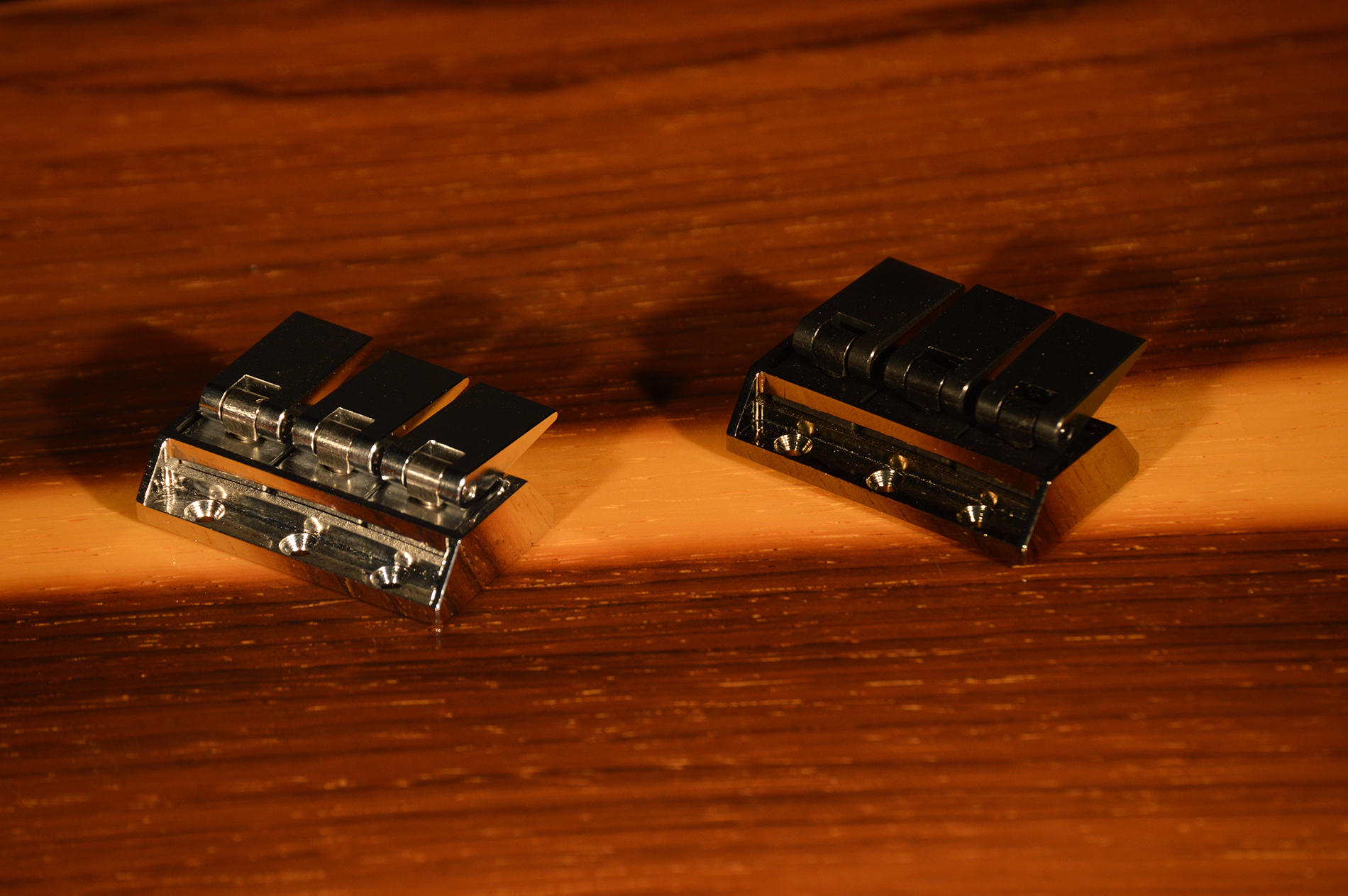
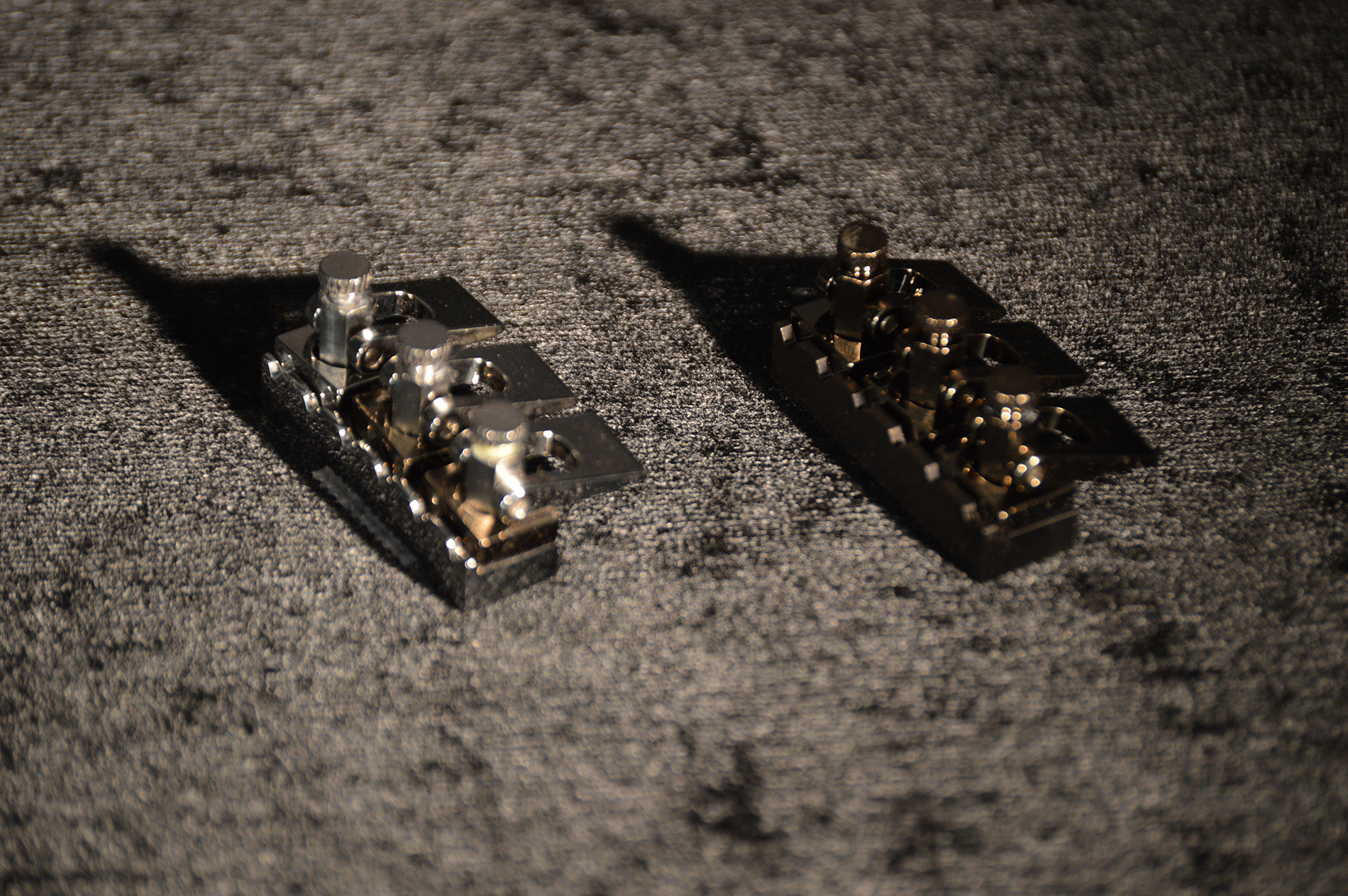
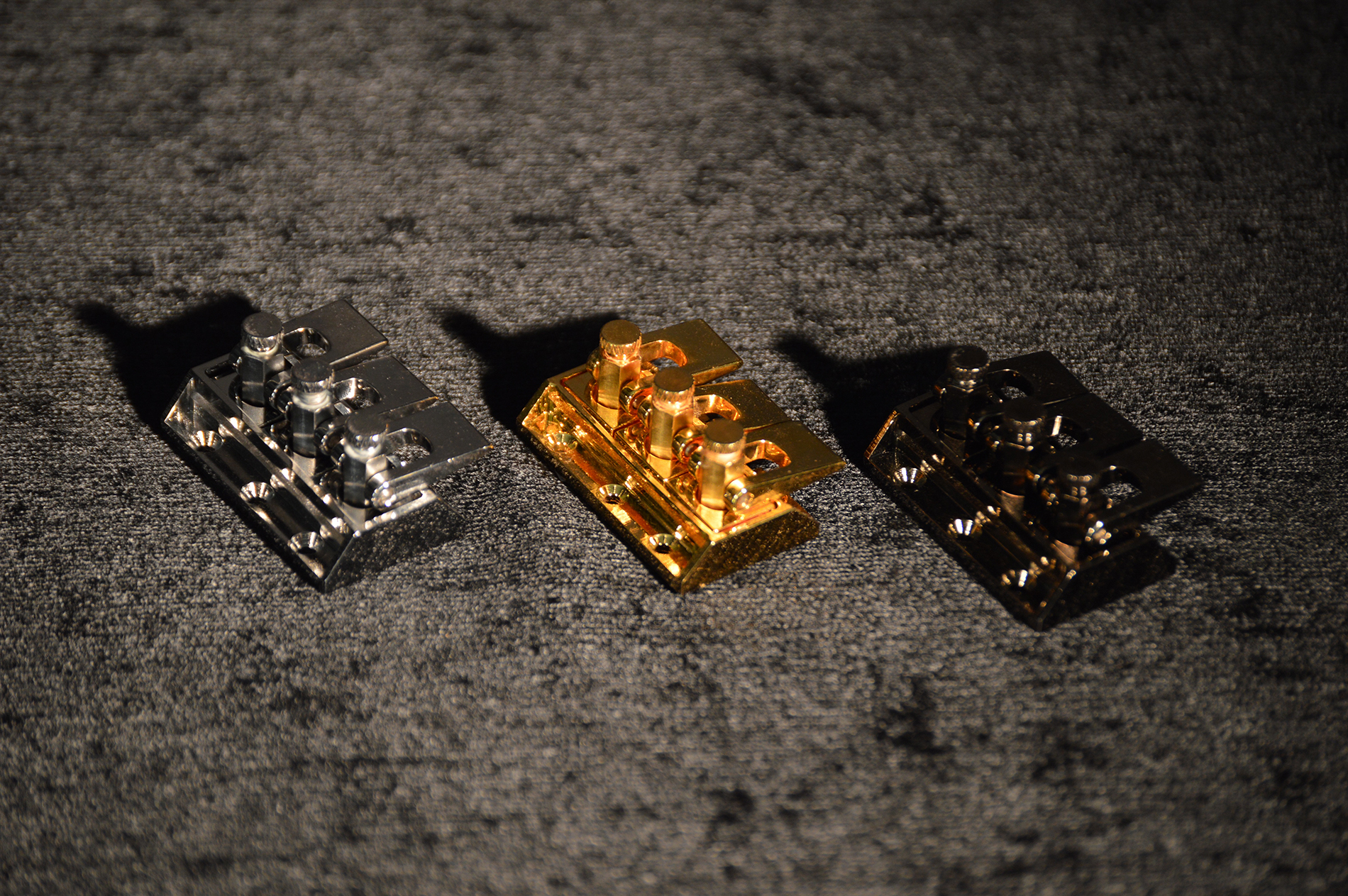

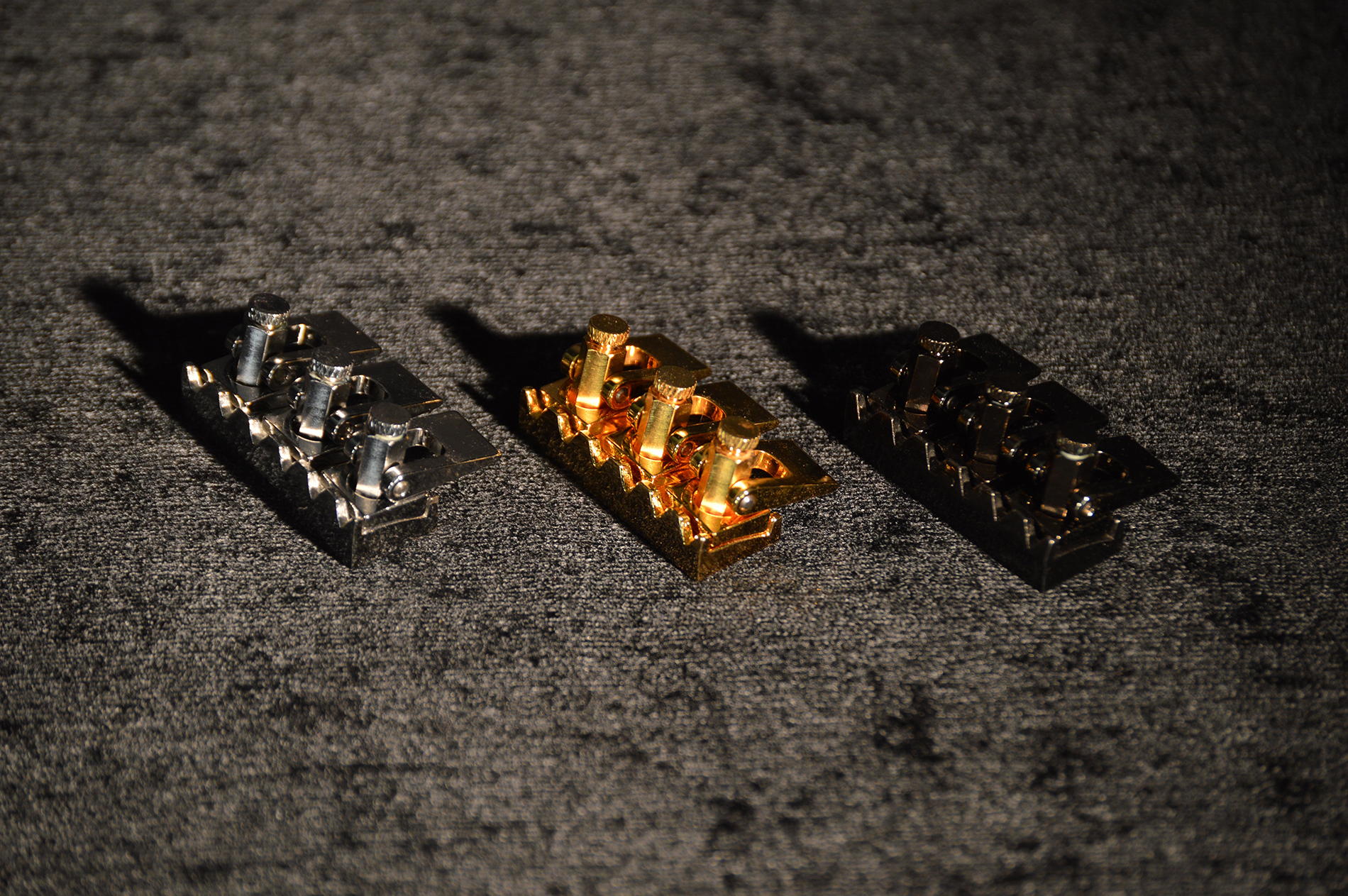
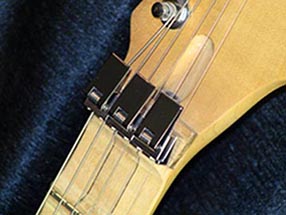
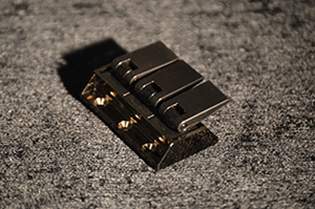
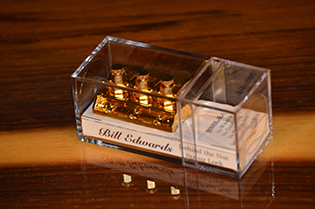

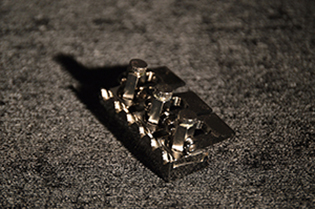


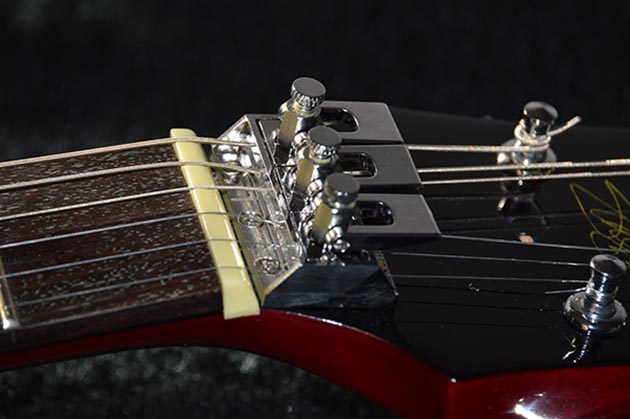
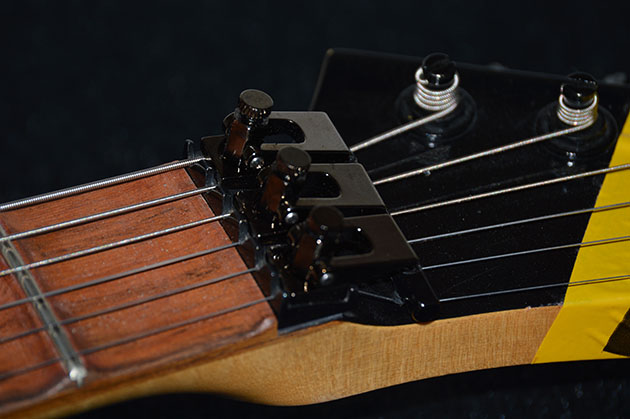
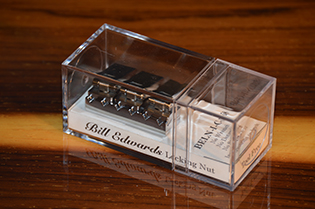 The Bill Edwards Locking Nut is the first device ever invented which allows a guitarist to lock and unlock strings at the nut without the need for an external tool. Equally important is the fact that locking a string pair with a hex wrench twists the strings out of tune! Our unique cam-lever design does not exert a twisting force on the strings, so it doesn't detune them when locking or unlocking. So it not only eliminates the wrench, it eliminates the need for secondary or so-clalled "fine tuners." That already makes two huge improvements to the existing technology. However there is a third, equally important advantage. Once you lock down the strings with a wrench, your primary tuners on your headstock are no longer accessible. Maddeningly, if you unlock the nut with a wrench to use the machine heads, you have to lock it back to use your tremolo and once again, you've just twisted the strings out of tune again! It's a viscious cycle. With our cam-lever design, access to the machine heads is just a quick flip away. It takes less than a second. Locking down the cam lever won't affect your pitch, so regaining access to your tuning machines adds a third distinct advantage over your old string locks: 1. No wrench, 2. No detuning and 3. Direct access to your headstock tuners. Changing strings used to be a time-consuming nighmare of tuning, wrench-clamping, fine-tuning, unclamping, retuning... until the strings finally stopped stretching. Now you won't have to waste hours dealing with the wrench problems. Your machine heads will be once again directly accessible. Problem solved!. Yes, our baseplates are direct retrofits for the old Floyd Rose baseplates. They also do away with the need for the string bar. Price: $79.95
The Bill Edwards Locking Nut is the first device ever invented which allows a guitarist to lock and unlock strings at the nut without the need for an external tool. Equally important is the fact that locking a string pair with a hex wrench twists the strings out of tune! Our unique cam-lever design does not exert a twisting force on the strings, so it doesn't detune them when locking or unlocking. So it not only eliminates the wrench, it eliminates the need for secondary or so-clalled "fine tuners." That already makes two huge improvements to the existing technology. However there is a third, equally important advantage. Once you lock down the strings with a wrench, your primary tuners on your headstock are no longer accessible. Maddeningly, if you unlock the nut with a wrench to use the machine heads, you have to lock it back to use your tremolo and once again, you've just twisted the strings out of tune again! It's a viscious cycle. With our cam-lever design, access to the machine heads is just a quick flip away. It takes less than a second. Locking down the cam lever won't affect your pitch, so regaining access to your tuning machines adds a third distinct advantage over your old string locks: 1. No wrench, 2. No detuning and 3. Direct access to your headstock tuners. Changing strings used to be a time-consuming nighmare of tuning, wrench-clamping, fine-tuning, unclamping, retuning... until the strings finally stopped stretching. Now you won't have to waste hours dealing with the wrench problems. Your machine heads will be once again directly accessible. Problem solved!. Yes, our baseplates are direct retrofits for the old Floyd Rose baseplates. They also do away with the need for the string bar. Price: $79.95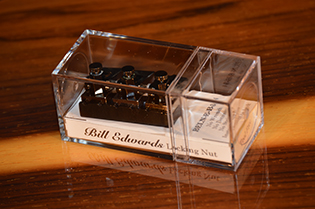 The Bill Edwards Locking Nut is the first device ever invented which allows a guitarist to lock and unlock strings at the nut without the need for an external tool. Equally important is the fact that locking a string pair with a hex wrench twists the strings out of tune! Our unique cam-lever design does not exert a twisting force on the strings, so it doesn't detune them when locking or unlocking. So it not only eliminates the wrench, it eliminates the need for secondary or so-clalled "fine tuners." That already makes two huge improvements to the existing technology. However there is a third, equally important advantage. Once you lock down the strings with a wrench, your primary tuners on your headstock are no longer accessible. Maddeningly, if you unlock the nut with a wrench to use the machine heads, you have to lock it back to use your tremolo and once again, you've just twisted the strings out of tune again! It's a viscious cycle. With our cam-lever design, access to the machine heads is just a quick flip away. It takes less than a second. Locking down the cam lever won't affect your pitch, so regaining access to your tuning machines adds a third distinct advantage over your old string locks: 1. No wrench, 2. No detuning and 3. Direct access to your headstock tuners. Changing strings used to be a time-consuming nighmare of tuning, wrench-clamping, fine-tuning, unclamping, retuning... until the strings finally stopped stretching. Now you won't have to waste hours dealing with the wrench problems. Your machine heads will be once again directly accessible. Problem solved! Yes, our baseplates are direct retrofits for the old Floyd Rose baseplates. They also do away with the need for the string bar. Price: $79.95
The Bill Edwards Locking Nut is the first device ever invented which allows a guitarist to lock and unlock strings at the nut without the need for an external tool. Equally important is the fact that locking a string pair with a hex wrench twists the strings out of tune! Our unique cam-lever design does not exert a twisting force on the strings, so it doesn't detune them when locking or unlocking. So it not only eliminates the wrench, it eliminates the need for secondary or so-clalled "fine tuners." That already makes two huge improvements to the existing technology. However there is a third, equally important advantage. Once you lock down the strings with a wrench, your primary tuners on your headstock are no longer accessible. Maddeningly, if you unlock the nut with a wrench to use the machine heads, you have to lock it back to use your tremolo and once again, you've just twisted the strings out of tune again! It's a viscious cycle. With our cam-lever design, access to the machine heads is just a quick flip away. It takes less than a second. Locking down the cam lever won't affect your pitch, so regaining access to your tuning machines adds a third distinct advantage over your old string locks: 1. No wrench, 2. No detuning and 3. Direct access to your headstock tuners. Changing strings used to be a time-consuming nighmare of tuning, wrench-clamping, fine-tuning, unclamping, retuning... until the strings finally stopped stretching. Now you won't have to waste hours dealing with the wrench problems. Your machine heads will be once again directly accessible. Problem solved! Yes, our baseplates are direct retrofits for the old Floyd Rose baseplates. They also do away with the need for the string bar. Price: $79.95 The Behind the Nut String Lock is a solution for guitars with tilt-back headstocks, where there is not enough material to rout for a locking nut. It is a big mistake to rout a tilt-back headstock such as a Gibson because the shape of the design at the joint is very slim to begin with, and already prone to breaking. Not as well known is the added weakness from the channel routed through to the headstock for the truss rod and its adjuster nut. It creates a surprisingly shallow part in the neck right in the joint between the neck and headstock, which is covered from above by a plastic plate, and therefore not so obvious to the untrained eye. Installing our BNSL requires no routing and no special tools or skills. A key difference between our BNSL and other behind-the-nut locks is that ours allows the strings to go directly from the nut slots to the tuning machine posts, without any interference with the path of travel. This is a significant advantage over all the others and one of the reasons locking and unlocking does not cause detuning as with everyone else's string locks. The same cam lever and timing adjusters that put our locking nuts in a class by themselves are another reason ours stay in tune and can be locked and unlocked in under a second with the touch of a finger. As with all our models: No Wrench, no detuning and you get back direct access to your headstock tuning machines. Perfect! Price: $89.95
The Behind the Nut String Lock is a solution for guitars with tilt-back headstocks, where there is not enough material to rout for a locking nut. It is a big mistake to rout a tilt-back headstock such as a Gibson because the shape of the design at the joint is very slim to begin with, and already prone to breaking. Not as well known is the added weakness from the channel routed through to the headstock for the truss rod and its adjuster nut. It creates a surprisingly shallow part in the neck right in the joint between the neck and headstock, which is covered from above by a plastic plate, and therefore not so obvious to the untrained eye. Installing our BNSL requires no routing and no special tools or skills. A key difference between our BNSL and other behind-the-nut locks is that ours allows the strings to go directly from the nut slots to the tuning machine posts, without any interference with the path of travel. This is a significant advantage over all the others and one of the reasons locking and unlocking does not cause detuning as with everyone else's string locks. The same cam lever and timing adjusters that put our locking nuts in a class by themselves are another reason ours stay in tune and can be locked and unlocked in under a second with the touch of a finger. As with all our models: No Wrench, no detuning and you get back direct access to your headstock tuning machines. Perfect! Price: $89.95 The Behind the Nut String Lock is a solution for guitars with tilt-back headstocks, where there is not enough material to rout for a locking nut. It is a big mistake to rout a tilt-back headstock such as a Gibson because the shape of the design at the joint is very slim to begin with, and already prone to breaking. Not as well known is the added weakness from the channel routed through to the headstock for the truss rod and its adjuster nut. It creates a surprisingly shallow part in the neck right in the joint between the neck and headstock, which is covered from above by a plastic plate, and therefore not so obvious to the untrained eye. Installing our BNSL requires no routing and no special tools or skills. A key difference between our BNSL and other behind-the-nut locks is that ours allows the strings to go directly from the nut slots to the tuning machine posts, without any interference with the path of travel. This is a significant advantage over all the others and one of the reasons locking and unlocking does not cause detuning as with everyone else's string locks. The same cam lever and timing adjusters that put our locking nuts in a class by themselves are another reason ours stay in tune and can be locked and unlocked in under a second with the touch of a finger. As with all our models: No Wrench, no detuning and you get back direct access to your headstock tuning machines. Perfect! Price: $89.95
The Behind the Nut String Lock is a solution for guitars with tilt-back headstocks, where there is not enough material to rout for a locking nut. It is a big mistake to rout a tilt-back headstock such as a Gibson because the shape of the design at the joint is very slim to begin with, and already prone to breaking. Not as well known is the added weakness from the channel routed through to the headstock for the truss rod and its adjuster nut. It creates a surprisingly shallow part in the neck right in the joint between the neck and headstock, which is covered from above by a plastic plate, and therefore not so obvious to the untrained eye. Installing our BNSL requires no routing and no special tools or skills. A key difference between our BNSL and other behind-the-nut locks is that ours allows the strings to go directly from the nut slots to the tuning machine posts, without any interference with the path of travel. This is a significant advantage over all the others and one of the reasons locking and unlocking does not cause detuning as with everyone else's string locks. The same cam lever and timing adjusters that put our locking nuts in a class by themselves are another reason ours stay in tune and can be locked and unlocked in under a second with the touch of a finger. As with all our models: No Wrench, no detuning and you get back direct access to your headstock tuning machines. Perfect! Price: $89.95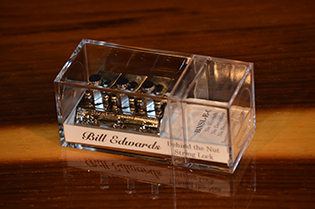 The Behind the Nut String Lock is a solution for guitars with tilt-back headstocks, where there is not enough material to rout for a locking nut. It is a big mistake to rout a tilt-back headstock such as a Gibson because the shape of the design at the joint is very slim to begin with, and already prone to breaking. Not as well known is the added weakness from the channel routed through to the headstock for the truss rod and its adjuster nut. It creates a surprisingly shallow part in the neck right in the joint between the neck and headstock, which is covered from above by a plastic plate, and therefore not so obvious to the untrained eye. Installing our BNSL requires no routing and no special tools or skills. A key difference between our BNSL and other behind-the-nut locks is that ours allows the strings to go directly from the nut slots to the tuning machine posts, without any interference with the path of travel. This is a significant advantage over all the others and one of the reasons locking and unlocking does not cause detuning as with everyone else's string locks. The same cam lever and timing adjusters that put our locking nuts in a class by themselves are another reason ours stay in tune and can be locked and unlocked in under a second with the touch of a finger. As with all our models: No Wrench, no detuning and you get back direct access to your headstock tuning machines. Perfect! Price: $89.95
The Behind the Nut String Lock is a solution for guitars with tilt-back headstocks, where there is not enough material to rout for a locking nut. It is a big mistake to rout a tilt-back headstock such as a Gibson because the shape of the design at the joint is very slim to begin with, and already prone to breaking. Not as well known is the added weakness from the channel routed through to the headstock for the truss rod and its adjuster nut. It creates a surprisingly shallow part in the neck right in the joint between the neck and headstock, which is covered from above by a plastic plate, and therefore not so obvious to the untrained eye. Installing our BNSL requires no routing and no special tools or skills. A key difference between our BNSL and other behind-the-nut locks is that ours allows the strings to go directly from the nut slots to the tuning machine posts, without any interference with the path of travel. This is a significant advantage over all the others and one of the reasons locking and unlocking does not cause detuning as with everyone else's string locks. The same cam lever and timing adjusters that put our locking nuts in a class by themselves are another reason ours stay in tune and can be locked and unlocked in under a second with the touch of a finger. As with all our models: No Wrench, no detuning and you get back direct access to your headstock tuning machines. Perfect! Price: $89.95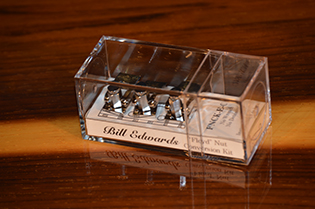 The Floyd Nut Conversion Kit is our latest variation after the BELN and the BNSL. This unique approach leverages our new external-adjuster cam lever assemblies with special curved lock blocks to convert your old wrench-style, detuning locking nut, into a new Bill Edwards FNCK Nut. You get all the same advantages of the BELN and the BNSL: No wrench, no detuning and you get back access to your headstock tuners with a flip of a finger. Here's maybe the best part: it only takes a few minutes to install and you don't even need to loosen your strings! You don't need special tools or skills. Say goodbye to out-of-date technology and tell your rusted old allen wrench to "Get FNCKed!" Price: $59.95
The Floyd Nut Conversion Kit is our latest variation after the BELN and the BNSL. This unique approach leverages our new external-adjuster cam lever assemblies with special curved lock blocks to convert your old wrench-style, detuning locking nut, into a new Bill Edwards FNCK Nut. You get all the same advantages of the BELN and the BNSL: No wrench, no detuning and you get back access to your headstock tuners with a flip of a finger. Here's maybe the best part: it only takes a few minutes to install and you don't even need to loosen your strings! You don't need special tools or skills. Say goodbye to out-of-date technology and tell your rusted old allen wrench to "Get FNCKed!" Price: $59.95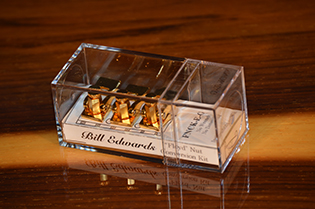 The Floyd Nut Conversion Kit is our latest variation after the BELN and the BNSL. This unique approach leverages our new external-adjuster cam lever assemblies with special curved lock blocks to convert your old wrench-style, detuning locking nut, into a new Bill Edwards FNCK Nut. You get all the same advantages of the BELN and the BNSL: No wrench, no detuning and you get back access to your headstock tuners with a flip of a finger. Here's maybe the best part: it only takes a few minutes to install and you don't even need to loosen your strings! You don't need special tools or skills. Say goodbye to out-of-date technology and tell your rusted old allen wrench to "Get FNCKed!" Price: $59.95
The Floyd Nut Conversion Kit is our latest variation after the BELN and the BNSL. This unique approach leverages our new external-adjuster cam lever assemblies with special curved lock blocks to convert your old wrench-style, detuning locking nut, into a new Bill Edwards FNCK Nut. You get all the same advantages of the BELN and the BNSL: No wrench, no detuning and you get back access to your headstock tuners with a flip of a finger. Here's maybe the best part: it only takes a few minutes to install and you don't even need to loosen your strings! You don't need special tools or skills. Say goodbye to out-of-date technology and tell your rusted old allen wrench to "Get FNCKed!" Price: $59.95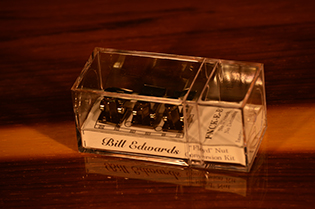 The Floyd Nut Conversion Kit is our latest variation after the BELN and the BNSL. This unique approach leverages our new external-adjuster cam lever assemblies with special curved lock blocks to convert your old wrench-style, detuning locking nut, into a new Bill Edwards FNCK Nut. You get all the same advantages of the BELN and the BNSL: No wrench, no detuning and you get back access to your headstock tuners with a flip of a finger. Here's maybe the best part: it only takes a few minutes to install and you don't even need to loosen your strings! You don't need special tools or skills. Say goodbye to out-of-date technology and tell your rusted old allen wrench to "Get FNCKed!" Price: $59.95
The Floyd Nut Conversion Kit is our latest variation after the BELN and the BNSL. This unique approach leverages our new external-adjuster cam lever assemblies with special curved lock blocks to convert your old wrench-style, detuning locking nut, into a new Bill Edwards FNCK Nut. You get all the same advantages of the BELN and the BNSL: No wrench, no detuning and you get back access to your headstock tuners with a flip of a finger. Here's maybe the best part: it only takes a few minutes to install and you don't even need to loosen your strings! You don't need special tools or skills. Say goodbye to out-of-date technology and tell your rusted old allen wrench to "Get FNCKed!" Price: $59.95